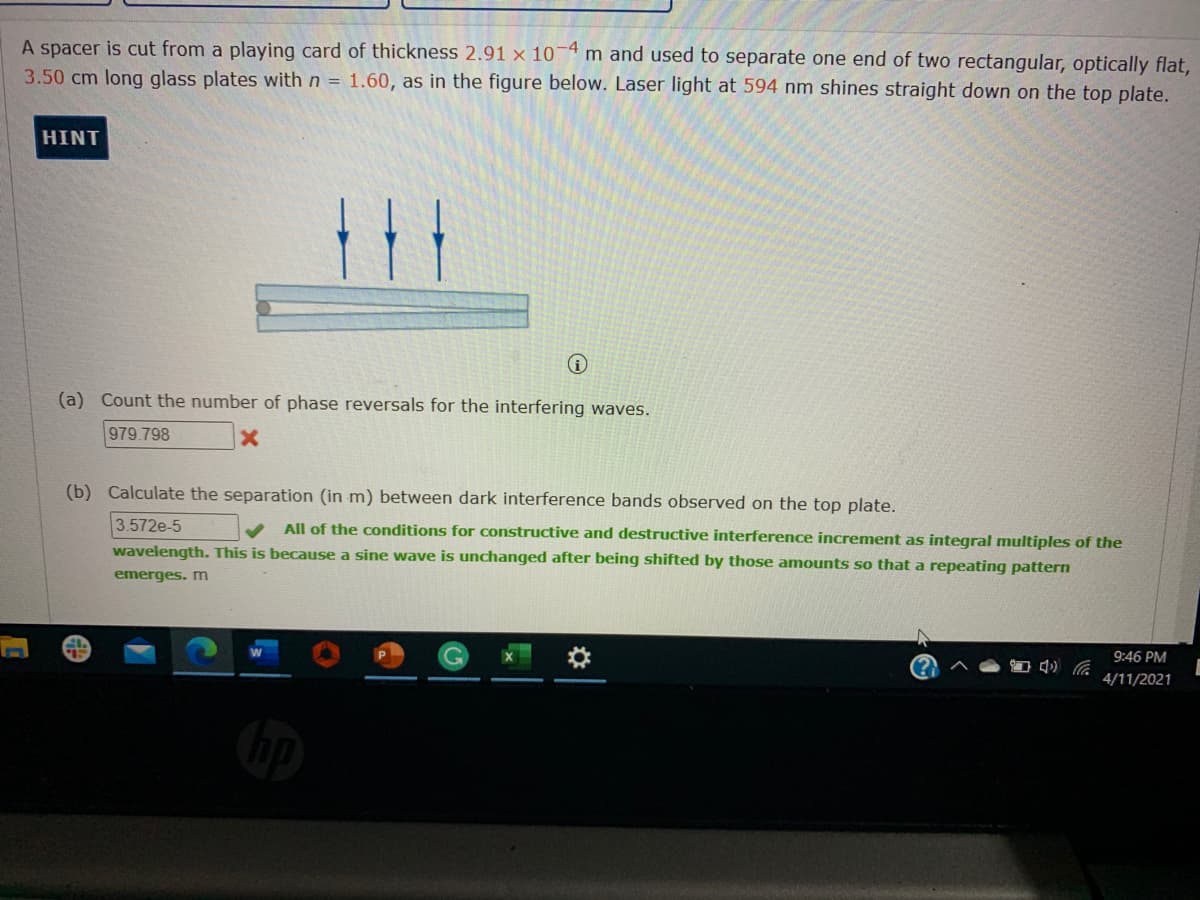A spacer is cut from a playing card of thickness 2.91 x 10-4 m and used to separate one end of two rectangular, optically flat, 3.50 cm long glass plates with n = 1.60, as in the figure below. Laser light at 594 nm shines straight down on the top plate. HINT (a) Count the number of phase reversals for the interfering waves. 979.798 (b) Calculate the separation (in m) between dark interference bands observed on the top plate. 3.572e-5 All of the conditions for constructive and destructive interference increment as integral multiples of the wavelength. This is because a sine wave is unchanged after being shifted by those amounts so that a repeating pattern emerges. m 9:46 PM 4/11/2021
A spacer is cut from a playing card of thickness 2.91 x 10-4 m and used to separate one end of two rectangular, optically flat, 3.50 cm long glass plates with n = 1.60, as in the figure below. Laser light at 594 nm shines straight down on the top plate. HINT (a) Count the number of phase reversals for the interfering waves. 979.798 (b) Calculate the separation (in m) between dark interference bands observed on the top plate. 3.572e-5 All of the conditions for constructive and destructive interference increment as integral multiples of the wavelength. This is because a sine wave is unchanged after being shifted by those amounts so that a repeating pattern emerges. m 9:46 PM 4/11/2021
Elements Of Electromagnetics
7th Edition
ISBN:9780190698614
Author:Sadiku, Matthew N. O.
Publisher:Sadiku, Matthew N. O.
ChapterMA: Math Assessment
Section: Chapter Questions
Problem 1.1MA
Related questions
Question

Transcribed Image Text:A spacer is cut from a playing card of thickness 2.91 x 10-4 m and used to separate one end of two rectangular, optically flat,
3.50 cm long glass plates with n = 1.60, as in the figure below. Laser light at 594 nm shines straight down on the top plate.
HINT
(a) Count the number of phase reversals for the interfering waves.
979.798
(b) Calculate the separation (in m) between dark interference bands observed on the top plate.
All of the conditions for constructive and destructive interference increment as integral multiples of the
wavelength. This is because a sine wave is unchanged after being shifted by those amounts so that a repeating pattern
3.572e-5
emerges. m
9:46 PM
4/11/2021
Expert Solution
This question has been solved!
Explore an expertly crafted, step-by-step solution for a thorough understanding of key concepts.
Step by step
Solved in 3 steps with 2 images

Knowledge Booster
Learn more about
Need a deep-dive on the concept behind this application? Look no further. Learn more about this topic, mechanical-engineering and related others by exploring similar questions and additional content below.Recommended textbooks for you

Elements Of Electromagnetics
Mechanical Engineering
ISBN:
9780190698614
Author:
Sadiku, Matthew N. O.
Publisher:
Oxford University Press

Mechanics of Materials (10th Edition)
Mechanical Engineering
ISBN:
9780134319650
Author:
Russell C. Hibbeler
Publisher:
PEARSON

Thermodynamics: An Engineering Approach
Mechanical Engineering
ISBN:
9781259822674
Author:
Yunus A. Cengel Dr., Michael A. Boles
Publisher:
McGraw-Hill Education

Elements Of Electromagnetics
Mechanical Engineering
ISBN:
9780190698614
Author:
Sadiku, Matthew N. O.
Publisher:
Oxford University Press

Mechanics of Materials (10th Edition)
Mechanical Engineering
ISBN:
9780134319650
Author:
Russell C. Hibbeler
Publisher:
PEARSON

Thermodynamics: An Engineering Approach
Mechanical Engineering
ISBN:
9781259822674
Author:
Yunus A. Cengel Dr., Michael A. Boles
Publisher:
McGraw-Hill Education

Control Systems Engineering
Mechanical Engineering
ISBN:
9781118170519
Author:
Norman S. Nise
Publisher:
WILEY

Mechanics of Materials (MindTap Course List)
Mechanical Engineering
ISBN:
9781337093347
Author:
Barry J. Goodno, James M. Gere
Publisher:
Cengage Learning

Engineering Mechanics: Statics
Mechanical Engineering
ISBN:
9781118807330
Author:
James L. Meriam, L. G. Kraige, J. N. Bolton
Publisher:
WILEY